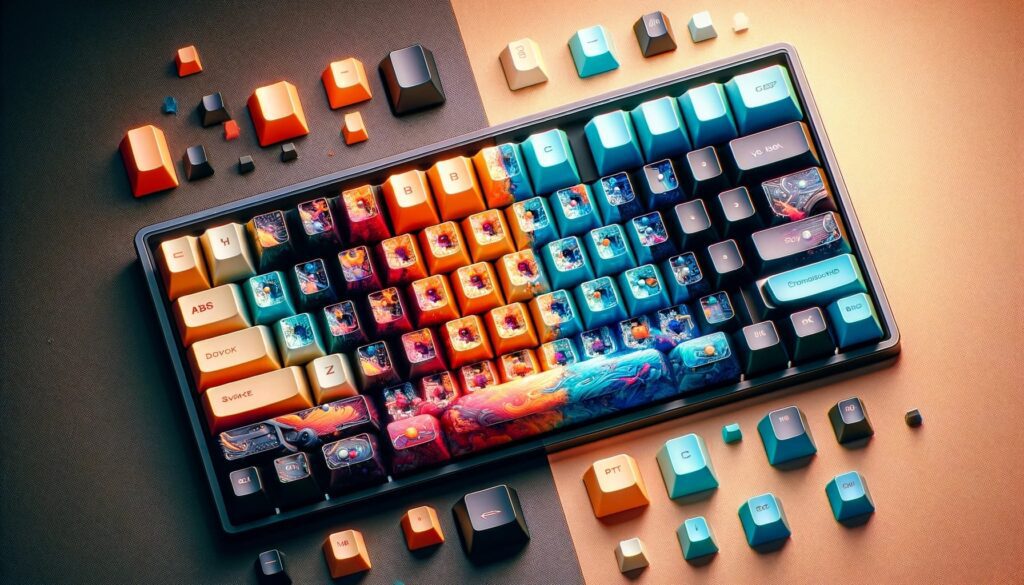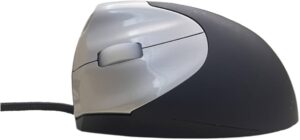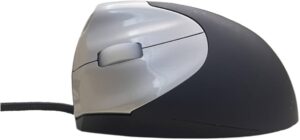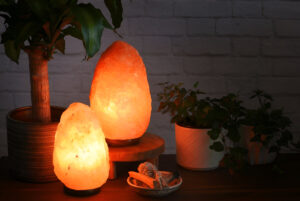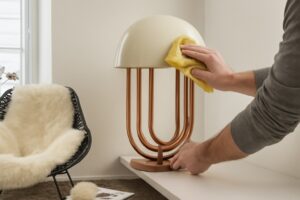Keycaps are the crucial touchpoints on our keyboards, blending functionality with aesthetic charm. In the realm of mechanical keyboards, two materials stand out: ABS (Acrylonitrile Butadiene Styrene) and PBT (Polybutylene Terephthalate). Each offers a distinct typing sensation and visual allure. This article delves into ABS vs PBT keycaps, examining their differences in feel, durability, sound, and user experience. Whether you’re an avid typist, a gamer, or intrigued by keyboard personalization, grasping these materials is key to making a well-informed choice.
Overview of ABS vs PBT Keycap Materials
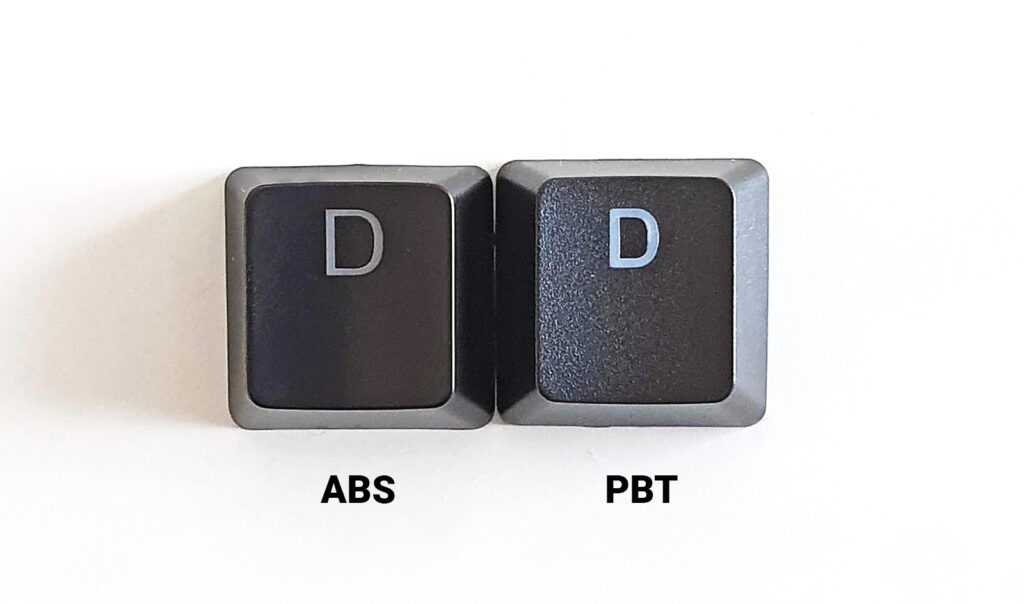
Keycaps significantly shape the keyboard experience. ABS and PBT plastics lead the pack in keycap production. ABS, a copolymer, is celebrated for its resilience, impact resistance, and cost-effectiveness. It’s widely used for its ease of production and versatility. PBT, on the other hand, is known for its sturdiness and resistance to wear and chemicals. It offers a more premium feel but at a higher production cost. Understanding these materials’ properties is crucial for discerning users who seek the perfect balance between tactile feedback and aesthetic appeal.
ABS keycaps are prevalent due to their affordability and manufacturability. Known for their smooth texture, they glide under the fingers, enhancing typing speed and comfort. However, this smoothness has a drawback. Over time, these keycaps can develop a greasy shine, altering their appearance and feel. This is a result of the material’s reaction to skin oils and UV exposure.
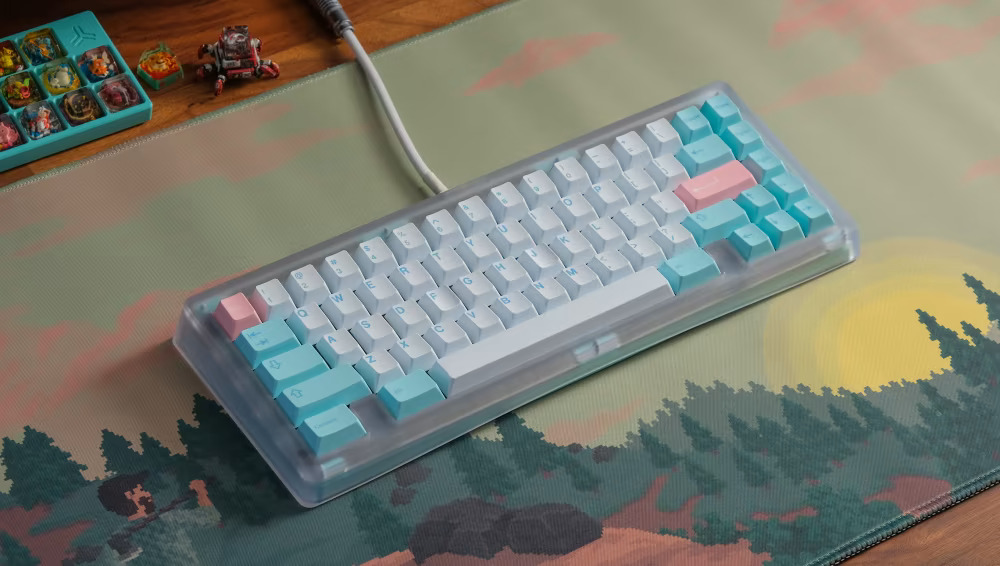
Material: ABS is a type of plastic known for its flexibility and ease of molding.
- Advantages: ABS keycaps are popular due to their smooth texture, making typing feel effortless and fast.
- Color and Design: They allow for vibrant colors and diverse designs, making them ideal for custom keyboard enthusiasts.
Durability Concerns:
- ABS keycaps tend to develop a shiny and worn appearance over time, especially under heavy use.
- The keycap legends (the printed letters or symbols) are prone to fading.
Cost and Variety:
- Generally more affordable than PBT.
- Available in a wide range of styles and thicknesses, including premium options.
| Attribute | Description |
|---|---|
| Texture | Smooth, prone to shininess |
| Durability | Less, prone to wear over time |
| Cost | Usually cheaper, varies with quality |
| Variety | Wide range, including custom designs |
Despite this, ABS keycaps are durable, resisting impacts effectively, a testament to their widespread use. They’re thinner, which some users prefer for their lightweight feel. High-quality ABS options exist, offering thicker profiles and enhanced durability, but at a price premium. The manufacturing process of ABS keycaps, typically involving injection molding, allows for varied designs and colors, making them a favorite for custom keyboard enthusiasts.
PBT keycaps, less common than ABS, are esteemed for their robustness and longevity. These keycaps are characterized by a textured, almost sandy feel, offering a distinct tactile experience. This texture, coupled with their matte finish, makes PBT keycaps less prone to developing a shiny appearance over time. PBT’s higher resistance to wear and chemicals contributes to its durability, maintaining quality even after prolonged use. However, these benefits come with a cost. PBT is more challenging to mold due to its rigidity and higher melting point, leading to higher production costs. This results in PBT keycaps typically being thicker and more expensive than their ABS counterparts, yet they offer a more consistent feel and longer lifespan.
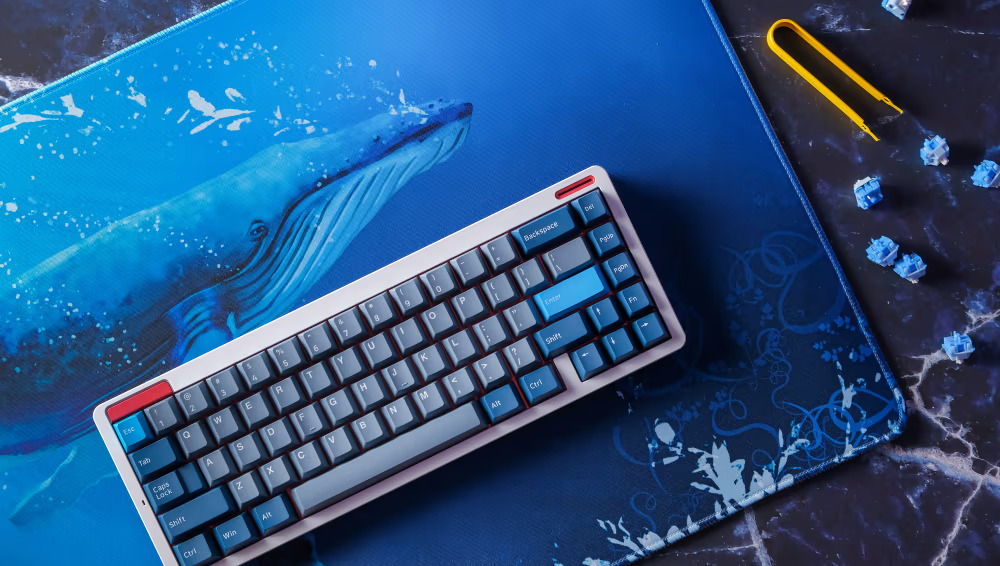
Material Attributes: PBT keycaps are known for their rigidity and durability.
- Texture: They offer a textured, almost sandy feel, preferred by many for its grip and premium sensation.
- Appearance: Typically have a matte finish, maintaining their quality look over time.
Longevity and Wear:
- PBT keycaps are more resistant to wear, keeping their texture and legends intact for longer.
- They are less likely to develop a shiny appearance compared to ABS.
Manufacturing and Cost:
- More challenging and costly to produce due to their material properties.
- Often thicker, adding to a solid and quality feel.
| Attribute | Description |
|---|---|
| Texture | Textured, matte finish |
| Durability | High, resistant to wear |
| Cost | Higher due to production challenges |
| Feel | Thicker, providing a solid feel |
Comparative Analysis
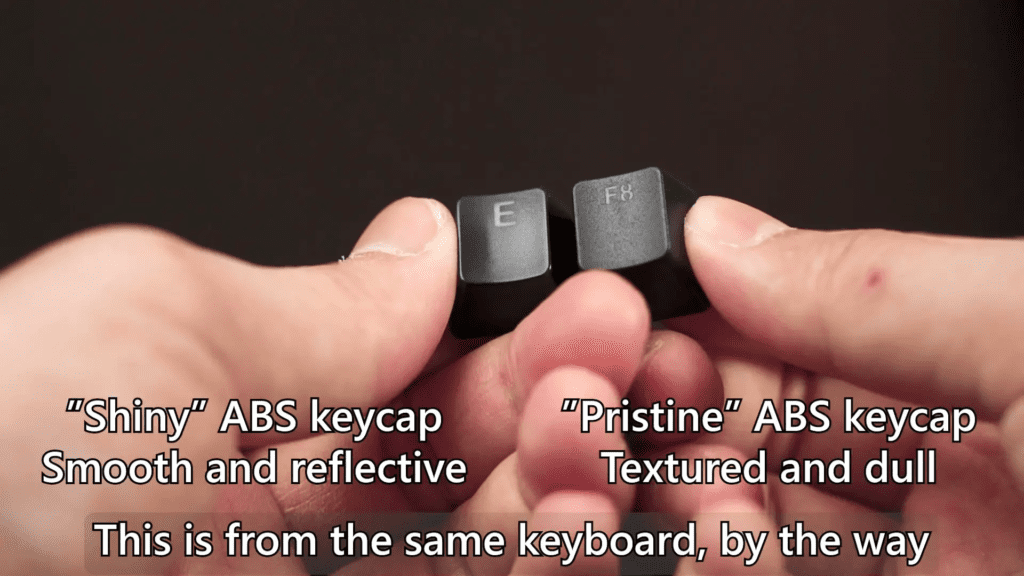
When comparing ABS and PBT keycaps, several key factors stand out:
| Aspect | ABS Keycaps | PBT Keycaps |
|---|---|---|
| Cost | Usually cheaper | More expensive |
| Texture | Smooth, shiny/greasy | Textured, matte |
| Durability | Less durable, prone to shine and wear | More durable, resistant to wear |
| Thickness | Thinner | Thicker |
| Sound | Quieter, higher pitched | Louder, deeper “thock” |
| Flexibility | More flexible | More rigid and brittle |
This table highlights the essential differences, helping users decide based on their preferences for texture, durability, sound, and cost.
Additional Keycap Variations
Beyond ABS and PBT, other keycap variations like Doubleshot and Pudding keycaps offer unique features. Doubleshot keycaps are made from two layers of plastic, ensuring that the legends never fade. They are perfect for backlit keyboards as they allow light to shine through the legends. Pudding keycaps take this a step further, with translucent sides that showcase the keyboard’s lighting, creating a visually striking effect. These variations are available in both ABS and PBT materials, allowing users to enjoy the benefits of their preferred material while adding an aesthetic flair to their keyboard setup.
Keycap Profiles and Customization
Keycap profiles significantly influence typing ergonomics and aesthetics. They vary in shape and height, with numerous profiles like Cherry, OEM, SA, and DSA offering diverse experiences. The profile choice affects finger travel and comfort, impacting overall typing speed and fatigue. Customization extends to material and color choices, allowing users to personalize their keyboards to their liking. Both ABS and PBT keycaps come in various colors and designs, catering to the aesthetic preferences of different users. This variety ensures that every keyboard can be as unique as its user, blending functionality with personal style.
Frequently Asked Questions (FAQs)
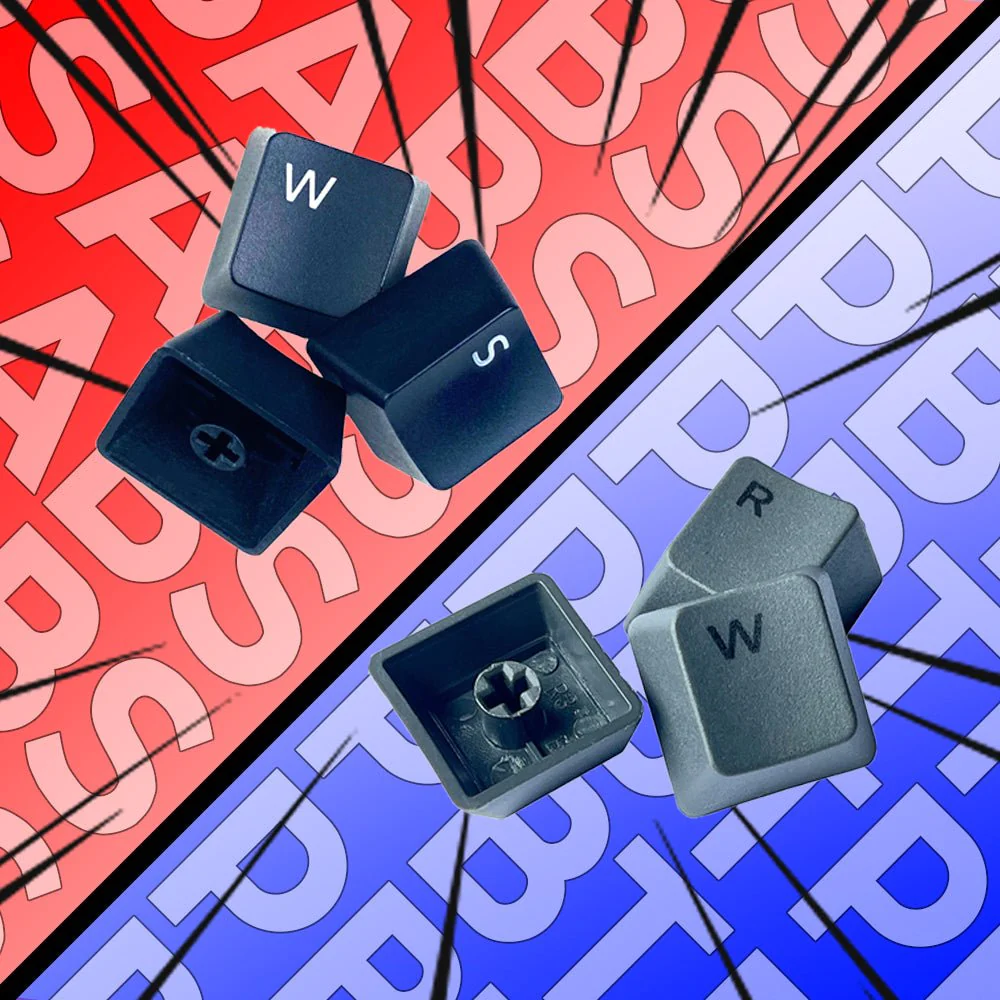
Q1: What are the main differences between ABS and PBT keycaps?
A1: ABS keycaps are smoother, cheaper, and more flexible, but wear down faster. PBT keycaps are more durable, have a textured feel, and maintain their quality longer.
Q2: Do ABS keycaps wear out quickly?
A2: Yes, ABS keycaps can develop a shiny look and have their legends fade with extensive use.
Q3: Why are PBT keycaps more expensive?
A3: PBT keycaps are costlier due to their more complex production process and their durable, high-quality material.
Q4: Can I get custom designs on both ABS and PBT keycaps?
A4: Yes, both ABS and PBT keycaps come in various designs and colors, allowing for customization.
Q5: Is the typing sound different between ABS and PBT keycaps?
A5: Yes, ABS keycaps tend to have a quieter, higher-pitched sound, while PBT keycaps produce a louder, deeper “thock” sound.
Q6: Are PBT keycaps better for heavy typists?
A6: Generally, yes. PBT keycaps are preferred for heavy use due to their durability and resistance to wear.
Q7: Can the texture of keycaps affect typing speed?
A7: Yes, the texture can influence typing comfort and speed. Smooth ABS keycaps might be faster for some, while others prefer the grip of PBT’s textured surface.
Conclusion and Personal Recommendation
In conclusion, both ABS and PBT keycaps have their unique strengths and cater to different user preferences. While PBT keycaps are generally more durable and offer a distinct texture, ABS keycaps are more accessible and provide a smoother typing experience. My personal recommendation leans towards PBT for their longevity and quality feel, particularly for users who type extensively. However, if you prioritize cost-effectiveness and a smoother feel, ABS keycaps are an excellent choice. Ultimately, the decision hinges on individual priorities like durability, feel, sound, and aesthetics. Happy typing!
To wrap up our exploration of ABS vs PBT keycaps, remember that the perfect keycap material depends on your personal preference and typing needs. If you’re keen on further refining your keyboard setup, dive into our in-depth reviews and guides at TechForDesk. Explore the nuances of keyboards like the RK68 in our RK68 Keyboard Review, or delve into our Ultimate WFH Desk Setup guide for holistic workspace improvements. For those always on the cutting edge, don’t miss our Top 5 Triple-Mode Keyboards of 2023 guide. Happy typing!
